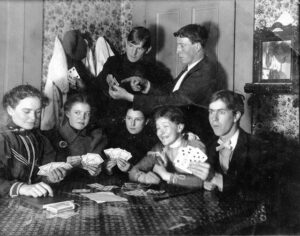Stopping by to visit the Little River Improvement Club and Museum these days, visitors may not realize the small white structure was once the social center of town.

The building itself, located 1.5 miles south of Mendocino on the east side of Highway 1, was built in 1885 for the Good Templars social improvement order. It served as the local gathering place for weddings, funerals, church services, town meetings, voting, painting and craft classes, a temporary school, and all kinds of parties.
When the ladies of the Little River Improvement Club took possession of the Hall back in 1915, after the Templars had abandoned it, they knew the building would need some up-keep. Card parties were the answer because their admission fees raised money for the materials. The menfolk, who enjoyed playing cards, were then available when their labor was needed for the improvements.
This party ticket, found in the Kelley House archives, is a relic from a 25-year period, the late 1920s to the early 1950s, when local folks were particularly fond of card parties.
So why were cards parties so popular in that era? As a historian I would guess part of it was ease of transportation, and the fact that games were just plain fun. This time period encompassed the Great Depression and World War II when cash was scarce and there wasn’t always gasoline to drive to nearby towns for entertainment. Plus, card parties don’t require a lot of equipment. All that was needed was a warm dry place with tables and chairs, light to see by, some decks of cards, and food.

Bridge was one of the popular card games, as was Whist, Rummy, Canasta, and a game called “Pedro” (pronounced pee-dro). The highest scores were rewarded with prizes, like homemade quilts or blankets. Consolation or “boobie” prizes were handed out for the less lucky. Participating in card games also earned you some local notoriety – the names of both the high and low scorers were reported by the Beacon’s Little River correspondents.
And you couldn’t beat the admission price. The first Card Party I found advertised, in November 1928, cost 25 cents for games and dinner. For a woman, an evening out sounded fun after a long day of cooking, cleaning, sewing or whatever. Likewise for a guy who, after a day working in the woods or fields, could put on clean clothes and head to the Hall with his wife on his arm or the expectation of meeting up with friends of both sexes. A good way to find a spouse!
Games started at 8 p.m. and dinner and coffee must have been served late. Sometimes there were pot-luck buffets and box socials. Do you know what box socials are? A woman made a meal for two and put it in a decorated box that was auctioned off, with the proceeds benefitting the Hall. The male bidder got to eat dinner with the woman who made the box. In 1946, a box social was reported to have made $37, with boxes selling for one to two dollars.
Card Parties could be private – invitations sent to Little River Improvement Club members only, or public – with everyone invited and advertised on posters and in the Beacon. By 1948 only the “Annual” Card Party was being advertised in the newspaper. By 1952 Bingo games seem to have replaced the Card Parties as popular fundraisers.
Here’s one last little peek at the social life of the historic Little River Improvement Club: the group enjoyed sponsoring “Old Fashioned Dances.” Attendees arrived in old-time costumes and danced to the music of their grandparents and great-grandparents – like the fox trot, the Charleston, or even the quadrille. The elders must have loved that.
Can you imagine an “Old-Fashioned Dance” today? You’d come all dressed up in your best tie-dye T-shirt with your fringe leather vest and a skirt made from an ethnic bedspread, wearing your hippie beads, and dance the Twist or the Jerk to music of the 1960s.
The Little River Improvement Club is still in existence and its charming hall with its Little River Museum are normally open on weekends in the summer.